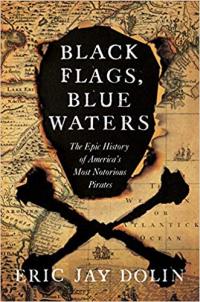 What is it about the pirates of the so-called “Golden Age” that holds our attention over the centuries? The period has been romanticized and fictionalized in books, British musicals, Hollywood movies, and cable TV shows. Where do the legend and lore end and the history begin?
What is it about the pirates of the so-called “Golden Age” that holds our attention over the centuries? The period has been romanticized and fictionalized in books, British musicals, Hollywood movies, and cable TV shows. Where do the legend and lore end and the history begin?
In Eric Jay Dolin’s latest book, Black Flags, Blue Waters – the Epic History of America’s Most Notorious Pirates, he cuts through the historical hyperbole and tells the still fascinating tale of these maritime brigands operating from the late 1600s through the early 1700s. In his account, he also shifts the focus away from strictly the Caribbean to the British North American colonies, which helps to put much of what can often seem to be merely fanciful tales into a historical context.
The “Golden Age of Piracy” was not a single period in history but rather three short and distinct outbreaks of oceanic banditry. Dolin explains the social and economic basis for each, from the buccaneers of Tortuga and Jamaica of the 17th century, to the so-called “Pirate Round” of the 1690s, to the decades following the War of the Spanish Succession in the early 18th century, from whence sprang most of the well known pirates we remember today.
The discussion of the so-called “Pirate Round” is particularly fascinating in part because it is often overlooked and also because it is so geographically unlikely. Pirate ships outfitted in the New York would sail roughly 10,000 miles to the Indian Ocean to attack Mughal treasure ships then sail the 10,000 miles back to New York, where they were welcomed for the gold and luxury goods that they brought to the currency-starved colonies. Briefly, New York City became a pirates den, half a world away from their hunting ground.
One of the more interesting points that Dolin makes is that the pirates were greeted warmly by the American colonists as long as the ill-gotten goods that they brought to market were stolen from someone else — Mughals or Spaniards. Only when the pirates attacked colonial ships did the colonial governments choose to turn against them.
In this sweeping arc of history, Dolin alternates between a broad perspective to establish a foundation for the actions and reactions of and to the pirates, and then provides us with close-ups of what is known of both the famous and more obscure pirates.
To Dolin’s credit, he does his best to cut through the romance and folklore that has accreted like barnacles around the better-known pirates. This is particularly challenging because even contemporaneous accounts could be embellished and unreliable.
The best-known source for biographies of pirate captains in the post-Spanish Succession period was Captain Charles Johnson‘s “A General History of the Pyrates” written in 1724. In it, for example, Johnson describes the pirate, Edward Thatch, better known as Blackbeard, in wildly memorable terms. In addition to his full black beard festooned with ribbons and a black coat strapped with multiple pistols, he was said to stick burning slow match beneath his hat that would sputter and smoke to make his look like a demon from hell. It is a wonderful description for which Dolin could find no other account beyond Johnson’s. Dolin notes that “no one built up the mythology of Blackbeard more enthusiastically than Johnson…” Dolin also suggests that Blackbeard’s reputation for brutality may be largely fictional.
Even without the embellishments, the pirate captains in Black Flags, Blue Waters are a fascinating group. From Sam Bellamy to Steed Bonnet, Blackbeard, Jack Rackham, Captain Kid, Charles Vane and the truly loathsome Edward Low, it is easy to understand why their legends have lived on in popular culture. I was also pleased to learn of a lesser known scoundrel, Dixie Bull, who was the first notable pirate on the coast of the British North American colonies. Though, as Dolin notes, “Dixie Bull was really not much of a pirate and his brief dalliance with debauchery spawned few imitators.”
“Black Flags, Blue Waters – the Epic History of America’s Most Notorious Pirates” is an entertaining and enlightening look at the often romanticized and misunderstood seagoing miscreants whose short and violent careers nevertheless resonate even to this day. Highly recommended.
